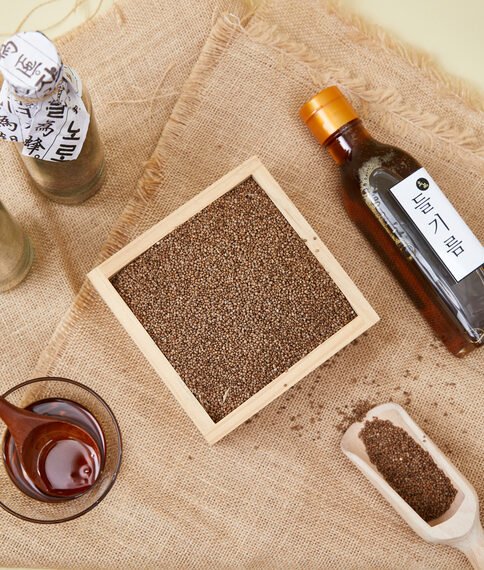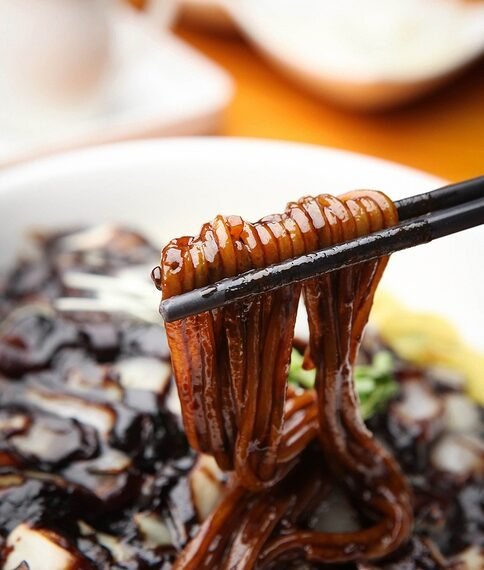In this article, we will show you how to make kimbap, the beloved Korean dish consisting of seaweed rice rolls filled with a variety of ingredients. From dried seaweed (gim) and rice to pickled radish and beef, kimbap offers a delightful blend of flavors and textures. We’ll guide you through the process, starting with the perfect rice seasoned with sesame oil and salt. Then, we’ll help you prepare the filling ingredients, ensuring they’re lightly seasoned and ready for rolling. Don’t worry if rolling seems tricky at first, practice makes perfect! We’ll also provide you with some helpful tips, like using freshly cooked rice and wetting your fingers to prevent sticking. With our step-by-step guide, you’ll be able to enjoy homemade kimbap anytime you crave it!
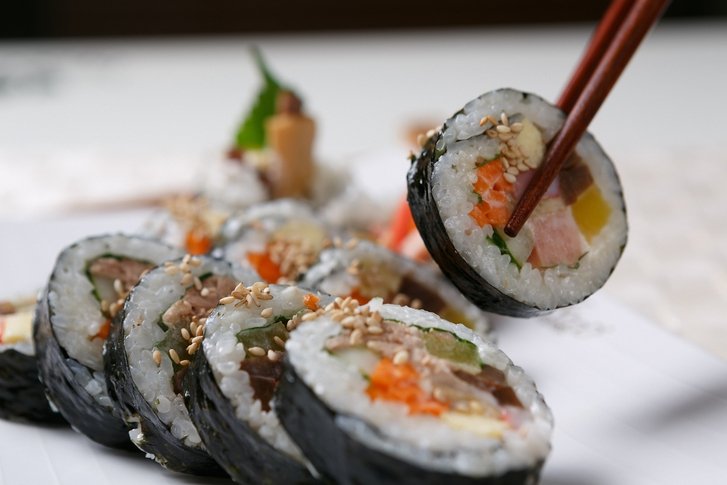
Ingredients
To make delicious kimbap at home, you will need the following ingredients:
Dried seaweed (gim)
Dried seaweed, also known as gim, is an essential ingredient in kimbap. It provides a savory and slightly salty flavor to the rice roll. You can easily find gim in Asian grocery stores or online.
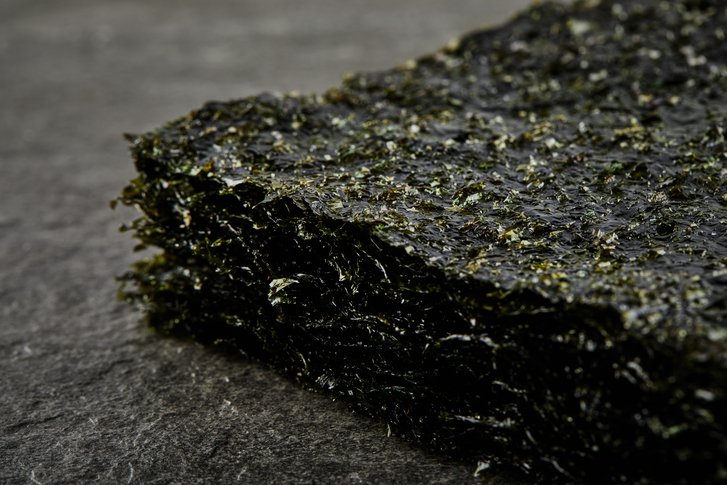
Short grain rice
Short grain rice is the preferred type of rice for making kimbap. It has a stickier texture, which makes it easier to roll. Rinse the rice thoroughly before cooking to remove excess starch.
Pickled radish
Pickled radish, also known as danmuji, adds a refreshing and tangy flavor to kimbap. It also provides a vibrant yellow color, making the rolls visually appealing. You can find pre-made pickled radish in most Asian grocery stores.
Beef
Thinly sliced beef is a common filling in kimbap. It adds a delicious and savory taste to the rolls. Marinate the beef in a mixture of soy sauce, sesame oil, garlic, and sugar to enhance its flavor.
Fish cake
Fish cake is another popular ingredient in kimbap. It has a slightly chewy texture and a mild taste. You can find fish cake slices in the frozen section of Asian grocery stores.
Eggs
Cooked eggs are a great addition to kimbap. They provide a creamy and subtle flavor that complements the other ingredients. Beat the eggs lightly and cook them into thin omelets before slicing them for the rolls.
Carrots
Carrots add a nice crunch and sweetness to kimbap. Julienne the carrots into thin matchstick-like pieces for easy rolling.
Spinach
Blanched spinach adds a vibrant green color and a fresh taste to kimbap. After blanching, squeeze out excess water and season the spinach with sesame oil and a pinch of salt.
Burdock root
Burdock root, also known as gobo, is a slightly sweet and earthy vegetable. Julienne the burdock root and blanch it in boiling water to soften before using it as a filling.
Sesame oil
Sesame oil is a key seasoning in kimbap. It adds a nutty and rich flavor to both the rice and the filling ingredients. Use it sparingly as a little goes a long way.
Salt
Salt is essential for seasoning the rice, beef, and other filling ingredients. It enhances the flavors and brings everything together.

Preparing the Rice
Cooking the rice
Start by rinsing the short grain rice thoroughly under cold water until the water runs clear. Then, measure the rice and add the appropriate amount of water in a rice cooker or a pot. Cook the rice according to the package instructions.
Seasoning the rice
Once the rice is cooked, transfer it to a large mixing bowl. Add a tablespoon of sesame oil and a pinch of salt to the rice. Mix well, ensuring that every grain of rice is coated with the sesame oil. Set aside and let the rice cool slightly.
Preparing the Filling
Prepping the beef
Thinly slice the beef against the grain into small, bite-sized pieces. In a bowl, combine soy sauce, sesame oil, minced garlic, and sugar. Add the beef slices to the marinade and allow them to marinate for at least 10 minutes. Once marinated, cook the beef over medium heat until fully cooked and slightly caramelized.
Preparing the fish cake
If using frozen fish cake slices, thaw them according to the package instructions. Then, cut them into thin strips that will fit easily into the kimbap rolls.
Cooking the eggs
Beat the eggs lightly in a bowl and season with a pinch of salt. Heat a non-stick pan over medium heat and pour the beaten eggs into the pan. Cook until the eggs are set and lightly browned on the bottom. Flip the omelet and cook for another minute. Transfer the cooked omelet to a cutting board and thinly slice it.
Preparing the carrots
Peel the carrots and cut them into thin matchstick-like pieces. You can use a knife or a julienne peeler for this. Blanch the carrot matchsticks in boiling water for about 1-2 minutes until slightly softened. Drain the carrots and set them aside.
Preparing the spinach
Bring a pot of water to a boil and blanch the spinach for about 30 seconds. Immediately transfer the blanched spinach to a bowl of ice water to stop the cooking process. Drain the spinach and squeeze out excess water. Season the blanched spinach with a drizzle of sesame oil and a pinch of salt.
Preparing the burdock root
Peel the burdock root and cut it into thin matchstick-like pieces. Bring a pot of water to a boil and blanch the burdock root for about 5 minutes until it becomes slightly tender. Drain the burdock root and set it aside.
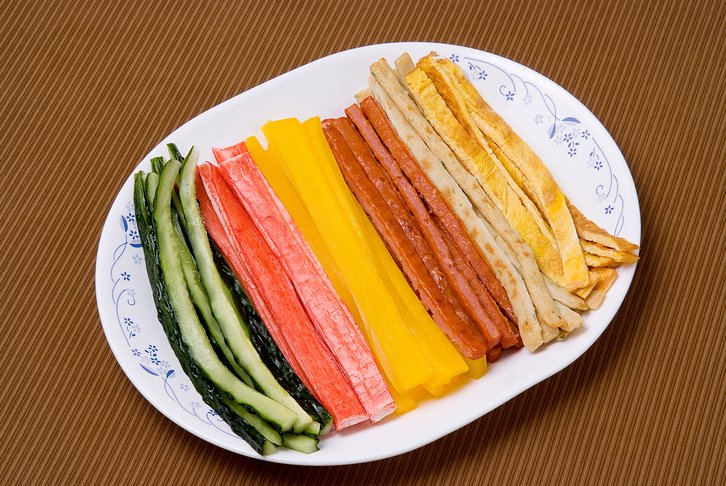
Assembling the Kimbap
Preparing the rolling mat
Place a bamboo rolling mat on a clean surface. Optionally, cover the mat with plastic wrap to prevent sticking. This will also make cleaning easier.
Placing the seaweed on the mat
Take a sheet of dried seaweed (gim) and place it on the rolling mat. Make sure the shiny side of the seaweed faces down and the longer side is facing you.
Spreading the rice on the seaweed
Using slightly wetted hands, take a small handful of seasoned rice and spread it evenly onto the seaweed, leaving a small border around the edges. Press gently to adhere the rice to the seaweed.
Adding the filling ingredients
Arrange the filling ingredients in a line across the center of the rice, leaving some space at the top and bottom for proper rolling. You can layer the ingredients or place them side by side, depending on your preference.
Rolling the kimbap
Using the bamboo mat, start rolling the kimbap away from you, using gentle but firm pressure to create a tightly rolled cylinder. Lift the bamboo mat as you roll, ensuring that the seaweed is tightly wrapped around the filling. Once rolled, use a small amount of water to seal the edge of the seaweed.
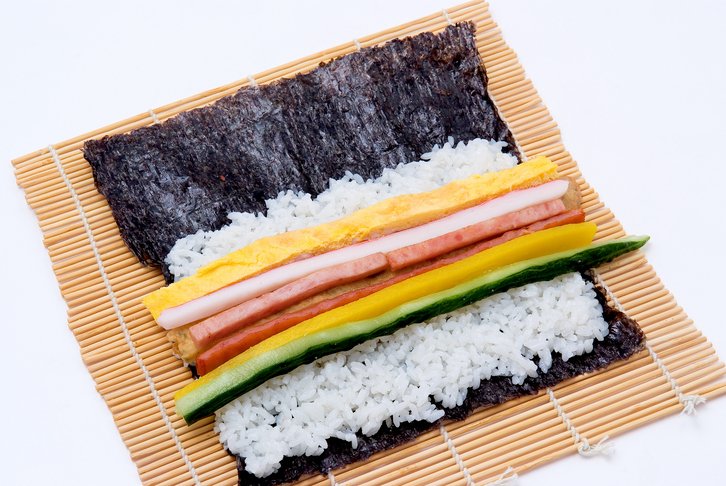
Tips for Making Kimbap
Using freshly cooked rice
For the best results, use freshly cooked rice while it is still warm. The warmth of the rice will make it easier to spread and roll.
Keeping the rice warm
While preparing the filling and assembling the kimbap, cover the rice with a clean kitchen towel to keep it warm. This will prevent the rice from drying out and becoming hard.
Wetting fingers with water or sesame oil
To prevent the rice from sticking to your fingers, lightly wet your fingers with water or sesame oil while spreading the rice on the seaweed. This will make it easier to handle and spread the rice evenly.
Starting with a small amount of filling
When adding the filling ingredients, start with a small amount. Overfilling the kimbap can make it difficult to roll tightly and may cause the roll to fall apart. Gradually add more filling as you become more comfortable with the rolling process.
Storing and Serving Kimbap
Storing sliced kimbap
If you have leftover sliced kimbap, store it in an airtight container in the refrigerator. However, kimbap is best enjoyed on the day it is made, as the seaweed can become soft and lose its crispness over time.
Reheating kimbap
To reheat kimbap, you can place it in the microwave for a few seconds until warm. Alternatively, you can lightly pan-fry the slices in a non-stick pan over medium heat until heated through.
Enjoying kimbap
Kimbap is a versatile dish that can be enjoyed as a snack, a light lunch, or even a picnic meal. Serve it as is or with a side of soy sauce for dipping.
Variations of Kimbap
Woo Young Woo kimbap recipe
One popular variation of kimbap is the Woo Young Woo kimbap, which is named after a famous Korean actress. This version omits beef and includes ham, crab sticks, fish cake, braised burdock root, egg, spinach, and carrot as the filling ingredients. The preparation and assembly process remain the same.
Step-by-Step Guide to Making Kimbap
Step 1: Gather all the ingredients
Before starting, gather all the necessary ingredients and equipment for making kimbap.
Step 2: Cook the rice
Rinse the short grain rice and cook it according to the package instructions.
Step 3: Season the rice
Transfer the cooked rice to a large mixing bowl and season it with sesame oil and salt. Mix well to coat every grain of rice.
Step 4: Prepare the beef
Thinly slice the beef and marinate it in a mixture of soy sauce, sesame oil, minced garlic, and sugar. Cook the marinated beef until fully cooked and slightly caramelized.
Step 5: Prepare the fish cake
Thaw the frozen fish cake slices and cut them into thin strips.
Step 6: Cook the eggs
Beat the eggs and cook them into thin omelets. Slice the cooked omelets into thin strips.
Step 7: Prepare the carrots
Peel the carrots and cut them into thin matchstick-like pieces. Blanch the carrots in boiling water until slightly softened.
Step 8: Prepare the spinach
Blanch the spinach in boiling water for a short time, then transfer it to ice water. Drain the spinach and season it with sesame oil and salt.
Step 9: Prepare the burdock root
Peel the burdock root and cut it into thin matchstick-like pieces. Blanch the burdock root in boiling water until tender.
Step 10: Assemble the Kimbap
Place a bamboo rolling mat on a clean surface. Place a sheet of dried seaweed on the mat, shiny side down. Spread the seasoned rice evenly on the seaweed, leaving a small border. Arrange the filling ingredients in a line across the center of the rice.
Step 11: Roll the kimbap tightly
Using the bamboo mat, start rolling the kimbap away from you, applying gentle but firm pressure. Lift the bamboo mat as you roll, ensuring a tight and compact roll. Seal the edge of the seaweed with a small amount of water.
Step 12: Slice and serve
Once rolled, use a sharp knife to slice the kimbap into bite-sized pieces. Serve and enjoy!
Now that you have all the necessary information and step-by-step instructions, it’s time to embark on your kimbap-making journey. Have fun experimenting with different fillings and enjoy this delicious and satisfying Korean dish!


